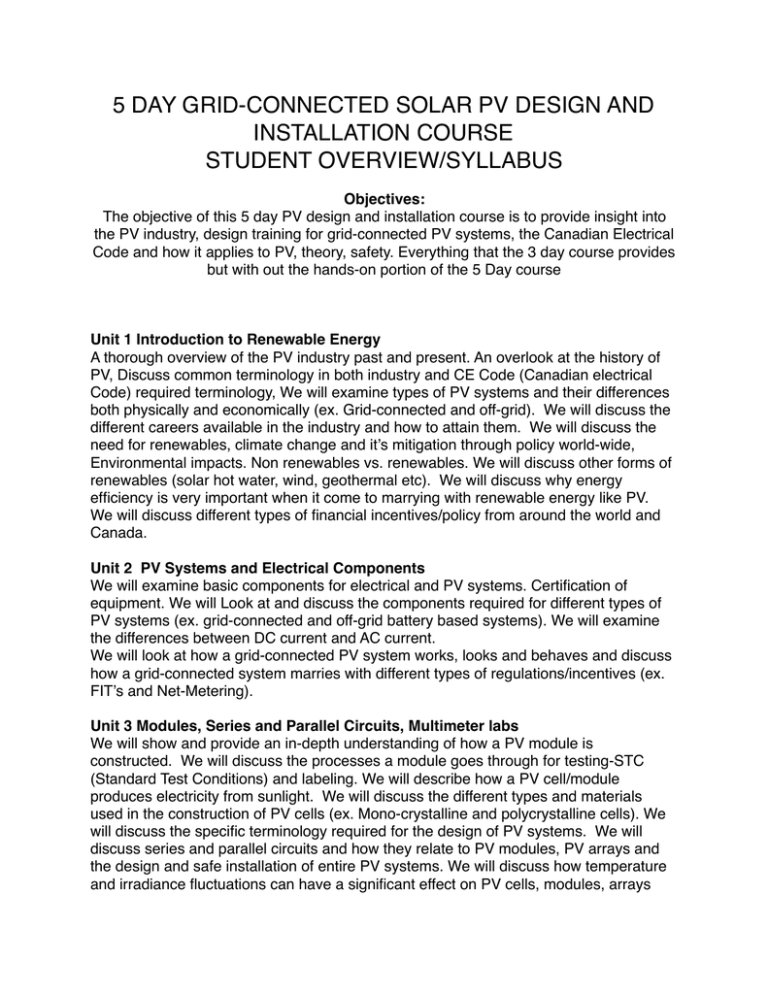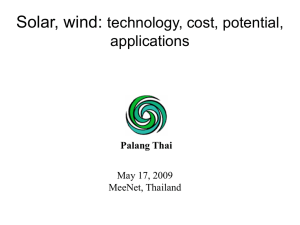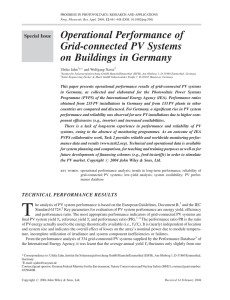5 Day Solar PV Design And installation course.pages
advertisement

5 DAY GRID-CONNECTED SOLAR PV DESIGN AND INSTALLATION COURSE STUDENT OVERVIEW/SYLLABUS Objectives: The objective of this 5 day PV design and installation course is to provide insight into the PV industry, design training for grid-connected PV systems, the Canadian Electrical Code and how it applies to PV, theory, safety. Everything that the 3 day course provides but with out the hands-on portion of the 5 Day course Unit 1 Introduction to Renewable Energy A thorough overview of the PV industry past and present. An overlook at the history of PV, Discuss common terminology in both industry and CE Code (Canadian electrical Code) required terminology, We will examine types of PV systems and their differences both physically and economically (ex. Grid-connected and off-grid). We will discuss the different careers available in the industry and how to attain them. We will discuss the need for renewables, climate change and it’s mitigation through policy world-wide, Environmental impacts. Non renewables vs. renewables. We will discuss other forms of renewables (solar hot water, wind, geothermal etc). We will discuss why energy efficiency is very important when it come to marrying with renewable energy like PV. We will discuss different types of financial incentives/policy from around the world and Canada. Unit 2 PV Systems and Electrical Components We will examine basic components for electrical and PV systems. Certification of equipment. We will Look at and discuss the components required for different types of PV systems (ex. grid-connected and off-grid battery based systems). We will examine the differences between DC current and AC current. We will look at how a grid-connected PV system works, looks and behaves and discuss how a grid-connected system marries with different types of regulations/incentives (ex. FIT’s and Net-Metering). Unit 3 Modules, Series and Parallel Circuits, Multimeter labs We will show and provide an in-depth understanding of how a PV module is constructed. We will discuss the processes a module goes through for testing-STC (Standard Test Conditions) and labeling. We will describe how a PV cell/module produces electricity from sunlight. We will discuss the different types and materials used in the construction of PV cells (ex. Mono-crystalline and polycrystalline cells). We will discuss the specific terminology required for the design of PV systems. We will discuss series and parallel circuits and how they relate to PV modules, PV arrays and the design and safe installation of entire PV systems. We will discuss how temperature and irradiance fluctuations can have a significant effect on PV cells, modules, arrays and design of PV systems (there will be labs for testing modules at this point). We will show I-V (current-voltage) curve characteristics of modules, arrays and PV system design. We will go through several exercises for the design of grid-connected PV systems and the basic math and formulas used. Unit 4 Solar Site Analysis and Mounting Solutions We will discuss site analysis, planning and implementation using the Solar Pathfinder and Solmetric Suneye via demonstration labs. Discuss the different instruments and tools required for solar site analysis. Discuss the need to understand azimuth (orientation), tilt angle, shading and debris, magnetic declination, roof type (material)/ condition and roof structures and how it all applies to PV systems and yearly energy production of PV systems. We will discuss the different mounting methods, costs associated, pros and cons with each type, and why you would choose one mounting method over another. Unit 5 Grid-Connected PV System Sizing We will discuss system sizing for a clients needs/desire/budget by addressing energy efficiency and why it’s important for people who are considering a grid-connected PV system. We will do this by addressing a clients habits when consuming (electrical) energy and by addressing a clients property and it’s ability or inability to accommodate a PV system. We will examine how to apply appropriate performance and deration factors based on specific installation, solar insolation and temperature co-efficient parameters, and code specific rules. We will introduce you to the math and formulas used to determine these. We will cover how to do proper load analysis on various electrical appliances using a watt meter. We will discuss how to determine the correct size of a grid-connected PV system for a client using a yearly kWh consumption derived from the clients electricity bills and we will discuss how to properly site a PV system, the amount of space needed, and whether there is a need for any upgrades to the structure, electrical system, and/or property. We will examine different types of grid-dependent inverters (string, central and micro inverters), their unique qualities and performance values, how to choose the proper one for your system and why, as well installation techniques and specifics. We will discuss how all of this will determine the system size and the number of PV modules and wiring configuration and type of inverter. Unit 6 Grounding and Bonding, Wiring, Over-current Protection, Electrical Configuration. All will be discussed according to Canadian Electrical Code. We will examine Grounding and bonding and the differences of the two when it comes to PV systems. How to properly bond and ground a PV system and why it is so important. We will look at different bonding and grounding material and bonding equipment specific to the PV industry. We will tie all the the previous units into how to properly determine the type, size and ratings of wiring/cabling, over-current protection (fusing and circuit breakers), and BOS (Balance Of System) components (ex. Disconnects, Junction boxes, combiner boxes etc). We will examine specific Canadian Electrical Code nomenclature. We will look at how to determine voltage drop and why it is important. Wire gauge and ampacities, types of conductors, size an colour coding of conductors and what it means. We will look at PV wire and PV specific connectors. We will look at different wire and cable protection methods (conduits and raceways). We will go through example of each. Unit 7 Installation and Building Integration, Commissioning, Troubleshooting and Maintenance, safety. We will examine the specifics when it comes to installation and building integration (mechanically and electrically) of grid-connected PV systems. We will examine different ways to attach PV systems mechanically to homes and buildings. We will examine safe and effective ways to integrate PV systems electrically to homes and buildings and how to deal with “Islanding and Anti-Islanding” issues for buildings with back-up generators. We will examine proper ways to commission PV systems, trouble shoot and maintain PV systems. We will examine safety issues and hazards specific and non-specific to the PV industry and specific regulations and enforcements there of and the duties of employers and employees. 2 Day’s Hands-On Installation. Students get the experience of installing a real-world grid-connected solar PV system. **Please Note: As per the Province or Alberta’s Electrician Trade Regulation 274/2000, Anyone who is not a Certified Electrician or Registered Electrical Apprentice will have to sign an "Acknowledgment and Release Waiver" stating that this training will not qualify you to design or install solar photovoltaic (PV) systems, and you will not be a certified solar PV installer as a result of completing the Course. Further, I understand and acknowledge that the installation, alteration, repair, inspection, verification, commissioning, maintenance and operation of electrical systems, including solar PV systems, must be performed by a certified Electrician.





